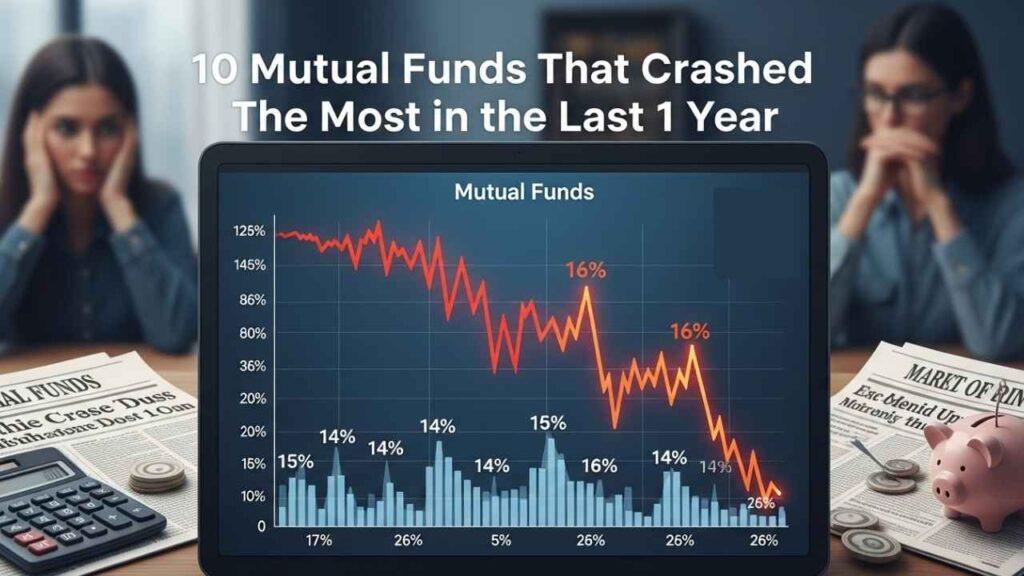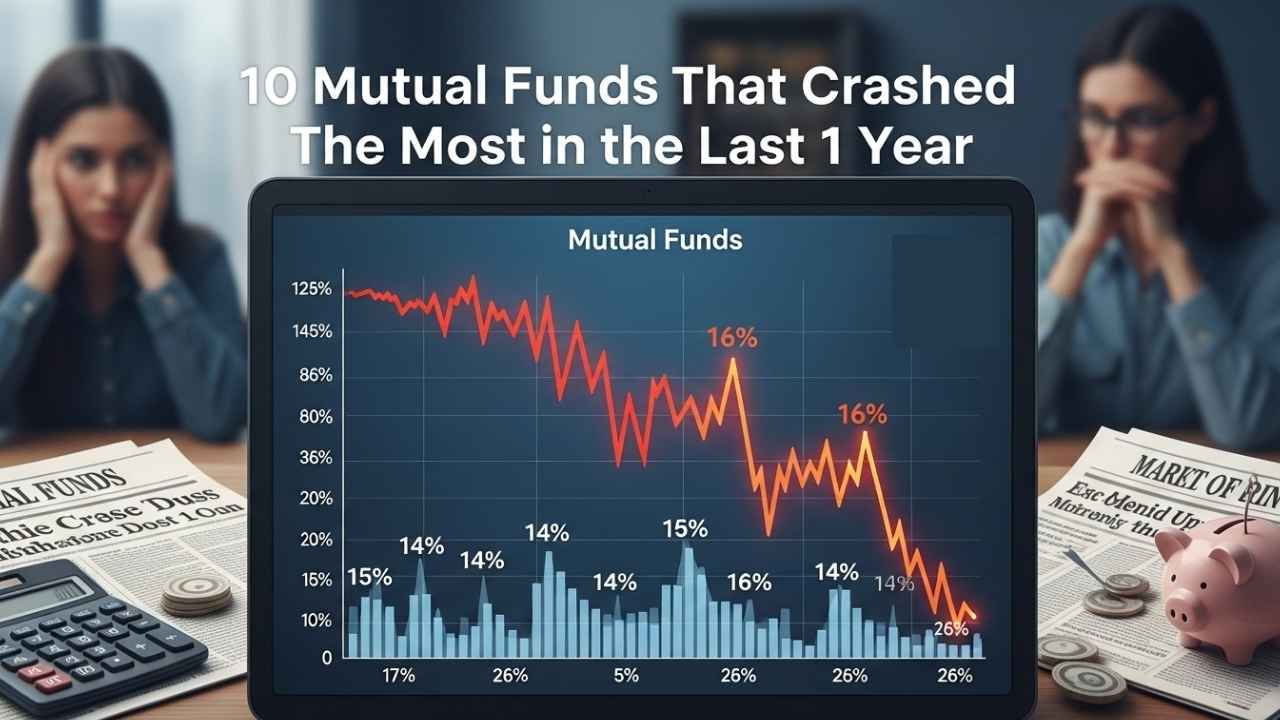Mutual Funds That Crashed the Most in the Last 1 Year- Hi friends! Investment in mutual funds can be a rollercoaster, isn’t it? Whereas some funds hit sky-high with dazzling returns, others go plummeting down, leaving investors puzzled. If you have been following the markets in 2025, you would realize that it has been a challenging year for specific industries. With economic slowdowns, sector-specific issues such as real estate downturns, and changes in momentum stocks, some mutual funds have plummeted.
In this article, we’re highlighting the 10 funds that collapsed the most in the past 1 year with returns of between -13.87% and -16.05%. This translates to a holding of ₹1 lakh one year ago worth between ₹83,950 and ₹86,130 – ouch! We’ll dissect the list, tell you why the funds could have bombed, and give you tips on how to avoid such mistakes. This is according to official announcements, and also recognize that most of these funds are fairly new, hence they don’t have much history to judge them from.
Whether you’re an experienced investor or new to the game, knowing about these underperformers can assist you in making more intelligent decisions. Let’s get started and learn from these failures!
Why Did These Mutual Funds Crash in 2025?
Let’s discuss the broad picture before we come to the list. 2025 has seen volatility. Some of the reasons impacting these funds are:
- Sector Woes: PSUs, manufacturing, realty, and consumption funds have been under pressure. Real estate, for example, had to deal with high interest costs and regulatory challenges, pulling down index funds linked to it.
- Momentum Shifts: Several of these are momentum funds, which gamble on those with good recent performance. But when the market turns around – as it does during a bearish cycle – they fall heavily.
- New Fund Risks: Several of these are new index or theme funds. Lacking a track record, they are susceptible to short-term market shocks.
- Wider Market Trends: Global uncertainties, inflation pressures, and domestic policy changes have affected equity funds more than debt ones this year.
Keep in mind, negative returns don’t necessarily make the fund “bad” forever – markets rebound, and long-term investing tends to iron out the wrinkles. But it’s a reminder to diversify and not follow hot trends blindfolded.
The Top 10 Worst-Performing Mutual Funds in the Last 1 Year
These are the 10 mutual funds that had the worst falls in the last year. I have listed them from the largest to the smallest decline, according to their 1-year return. To give you some idea, I have also included how much ₹1 lakh, which was invested a year ago, would be equivalent to today. Figures are as of official disclosures as on the last reports.

| Rank | Fund Name | 1-Year Return (%) | 1 Lakh Would Have Become (₹) |
|---|---|---|---|
| 1 | Quant PSU Fund | -16.05 | 83,950 |
| 2 | Quant Manufacturing Fund | -15.65 | 84,350 |
| 3 | Tata Nifty Realty Index Fund | -14.72 | 85,280 |
| 4 | HDFC NIFTY Realty Index Fund | -14.10 | 85,900 |
| 5 | ICICI Prudential Nifty 200 Momentum 30 Index Fund | -14.10 | 85,900 |
| 6 | HDFC NIFTY200 Momentum 30 Index Fund | -14.09 | 85,910 |
| 7 | Bandhan Nifty200 Momentum 30 Index Fund | -14.06 | 85,940 |
| 8 | Motilal Oswal Nifty 200 Momentum 30 Index Fund | -13.93 | 86,070 |
| 9 | Samco Flexi Cap Fund | -13.93 | 86,070 |
| 10 | Quant Consumption Fund | -13.87 | 86,130 |
These statistics indicate the areas of pain. To illustrate, the Quant PSU Fund, leading this dismal list, fell more than 16%, reducing ₹1 lakh to a mere ₹83,950. It’s linked to public sector firms, which have had to contend with government policy lag and private sector competition.
Meanwhile, funds such as the Quant Consumption Fund, which fell “only” 13.87%, invest in consumer goods industries that decelerated because of trimmed spending under economic strain.
Breaking Down the Categories: What Went Wrong?
For context, let’s categorize these funds and discuss why they collapsed:
- Sector-Specific Funds (PSU, Manufacturing, Realty, Consumption): Funds such as Quant PSU, Quant Manufacturing, Tata Nifty Realty Index, and Quant Consumption bet big on niche domains. In 2025, PSUs and manufacturing ran into roadblocks in the form of supply chain woes and exports slowdowns. Realty funds lost money due to a property market correction – high home loan rates deterred buyers, affecting real estate stocks.
- Momentum Index Funds: A large proportion here – ICICI Prudential Nifty 200 Momentum 30, HDFC NIFTY200 Momentum 30, Bandhan Nifty200 Momentum 30, and Motilal Oswal Nifty 200 Momentum 30 – follow “momentum” shares (those quickly advancing). But momentum is fleeting in turbulent markets, and trends can change direction suddenly, resulting in steep falls.
- Flexi Cap Funds: Samco Flexi Cap is more flexible, investing in all market caps, but even that could not outrun the broader equity decline, if at all it had exposure to poorly performing sectors.
Since most of them are index funds, they track benchmarks such as Nifty Realty or Nifty 200 Momentum passively. When those indices collapse, the funds collapse along with it – no active management to soak up the shock.
Pro tip: Newer funds (created in the recent 2-3 years) do not have the cushioning of older ones. Always verify the inception date before investing.
Lessons Learned: How to Avoid Investing in Crashing Funds
Witnessing these crashes is a wake-up call. Here’s how to save your portfolio:
- Diversify, Diversify, Diversify: Don’t invest everything in one sector or theme. Combine equity with debt funds for diversification.
- Don’t Look at 1-Year Returns: Short-term falls are normal. Look at 3-5 year returns if available – but as most here are new ones, that’s a warning sign.
- Know the Fund Type: Index funds are inexpensive but blindly replicate the market. Active funds may avoid some misses with intelligent choices.
- Time Your Purchase: Invest systematically using SIPs (Systematic Investment Plans) and invest step by step, thereby smoothing out costs during falls.
- Watch Market Trends: Monitor industries. For 2025, realty and momentum have been poor – perhaps shift to defensives such as pharma or IT.
- Exit Strategy: Have stop-loss guidelines or rebalance every year. Don’t cling to losers waiting for a miracle.
- Consult Experts: In case you are not sure, seek the help of a financial advisor. They can customize picks according to your risk tolerance.
Investing is not about preventing losses altogether – it’s about minimizing them. These dollars may regain if industries pick up, so if you’re in one, don’t panic-sell; check your goals first.
Learn More:
- Difference in Expense Ratio Between Direct and Regular Mutual Funds
- Best Small-Cap Index Funds
- 10 Debt Mutual Funds That Outperformed in the Last 1 Year with 10% to 24% Returns in 2025
Wrapping Up: Turn These Crashes into Smart Investing Wins
2025 has been merciless for these 10 funds, with declines as high as 16% sending investments into a tailspin. From Quant PSU Fund’s big plunge to Quant Consumption’s less severe dip, it’s safe to say that sector bets and momentum plays are a losing proposition in bad times. But hey, each market bottom is a teachable moment – and maybe a buying opportunity for the fearless.
If you’ve been struck by any of these or have tales in your portfolio, comment below! Let’s talk strategies for the remainder of 2025. And if this article saved you from a poor selection, share this post!
Stay in, stay knowledgeable, and remember: Building wealth is a marathon, not a sprint!
Disclaimer: Information only and not a financial advisory. Investments in mutual funds are market risks. Always read the scheme papers and consult a certified consultant before making an investment. Figures based on official disclosures for the previous 1 year; performance may change.










